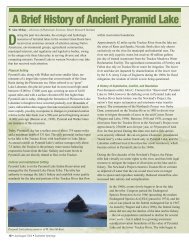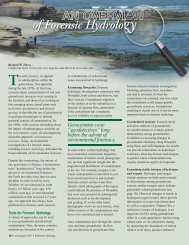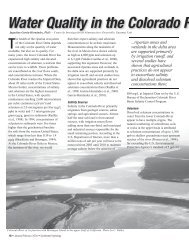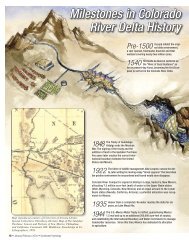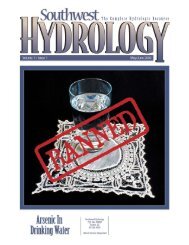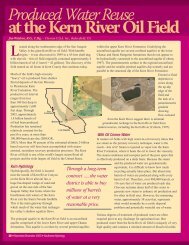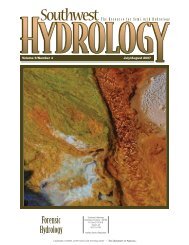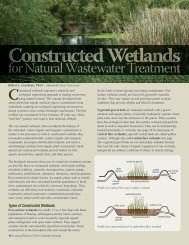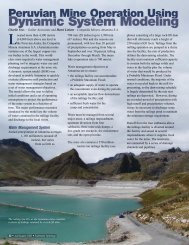The Hydrology of Pit Lakes Lee C. Atkinson - Southwest Hydrology
The Hydrology of Pit Lakes Lee C. Atkinson - Southwest Hydrology
The Hydrology of Pit Lakes Lee C. Atkinson - Southwest Hydrology
Create successful ePaper yourself
Turn your PDF publications into a flip-book with our unique Google optimized e-Paper software.
<strong>The</strong> <strong>Hydrology</strong> <strong>of</strong> <strong>Pit</strong> <strong>Lakes</strong><strong>Lee</strong> C. <strong>Atkinson</strong>, Ph.D. – Hydrologic Consultants, Inc. <strong>of</strong> ColoradoWhen mining and dewatering activitiescease in any surface mine below the localwater table, the excavation will begin t<strong>of</strong>ill with groundwater and form a pit lake.<strong>The</strong> hydrologic system, both the groundwaterand surface-water components, willthen begin to establish a new equilibriumthat might or might not be similar to preminingconditions.<strong>The</strong> rate at whichthis occurs and theextent to which premininghydrologicconditions arerestored depends onthe local hydrogeology, the size <strong>of</strong> the pit,the magnitude and duration <strong>of</strong> dewateringduring mining, and the climaticconditions. In any case, pit lakes act asartificial “windows” in the water tableand, because <strong>of</strong> evaporation, becomeessentially permanent points <strong>of</strong> groundwaterwithdrawal.Hydrologic Budget for a <strong>Pit</strong> Lake<strong>The</strong> hydrologic budget (or water balance)for a pit lake can be described in terms <strong>of</strong>volumes (i.e., fluxes x time) by theequation:V in =V out + V e + V ∆swhereV in = volume <strong>of</strong> ground-water inflowV out = volume <strong>of</strong> ground-wateroutflowV e = volume <strong>of</strong> evaporation from pitlake surfaceV ∆s = change in volume <strong>of</strong> storage(change in water level x area)This budget is shown in Figure 1. It isassumed that engineered drainage ditchesand diversions will keep surface water out<strong>of</strong> a pit both during and post-mining. Ofcourse, in some mines there may beoccasional and presumably short-livedinflows <strong>of</strong> surface water, but they are notincluded in the generic water balance for atypical pit lake.14 • September/October 2002 • <strong>Southwest</strong> <strong>Hydrology</strong><strong>The</strong> rate <strong>of</strong> ground-water inflow isproportional to two primary factors: 1) thehydraulic conductivity (or permeability) <strong>of</strong>the rocks comprising the pit and 2) thehydraulic gradient between the water levelin the pit at any point in time and somedistant point where the water level hasbeen essentially unaffected by mining and<strong>The</strong> potential worst case may occur where both inflow andevaporation are moderate and there is outflow <strong>of</strong> evapoconcentratedwater with high concentrations <strong>of</strong> certain constituents.dewatering. <strong>The</strong> latter is a function <strong>of</strong> thehydraulic conductivity and storageproperties <strong>of</strong> the intervening materials andthe time since dewatering began. <strong>The</strong> nearpithydraulic gradient, induced bydewatering and pit infilling, changes overtime, with the steepest gradient occurringat the end <strong>of</strong> dewatering, when pit lakerecovery begins. This is shownschematically in Figure 2. Because thehydraulic gradients are steepest duringearly pit lake recovery, the rate <strong>of</strong> infillingis greatest during early recovery anddecreases with time. <strong>The</strong> rate <strong>of</strong> infilling isalso a function <strong>of</strong> the volume per unitdepth <strong>of</strong> the pit, which increasessignificantly as the pit lake fills, a function<strong>of</strong> the conical shape <strong>of</strong> the pit. If a) thehydraulic conductivity is relatively large,b) dewatering has occurred for a relativelylong time (say 10+ years), and c) thestorage <strong>of</strong> the rocks is low (which is thecase for most bedrock), then the time <strong>of</strong>infilling can be quite long.Evaporation can be a major variable in thepit lake infilling process. As used here, theterm includes the net loss <strong>of</strong> water fromthe pit lake surface (evaporation less directprecipitation) and any evapotranspirationfrom either aquatic or phreatophyticvegetation associated with the pit lake. Insome cases, the evaporation can beestimated from pan rates or publishedvalues for shallow lakes. In other cases,the process is much more complicated andfactors such as water temperature, airtemperature, wind speed, and humidity,and even lake factors including shape,fetch, shading, and seasonal turnover, mustbe considered. In areas where either thewater temperature is geothermallyelevated or pan rates do notrepresent the winter months, asimple pan rate might not beapplicable.EvapoconcentrationEvaporation from the pit lakesurface causes concentrations<strong>of</strong> dissolved constituents within the pitlake water to increase over time. This isdescribed by the approximate, transientrelationship:C t = M t M t - 1 + ∑(V in C in -V out C t - 1)=V t V t - 1 + V ∆swhereC = concentrationM = mass in solutionV = volume <strong>of</strong> water in pit laket = time<strong>The</strong> evapoconcentration factor typicallyranges from 10 to 40 times theconcentration in the ground-water inflow.In the case <strong>of</strong> constituents such as arsenic,selenium, and many trace metals,evapoconcentration is a majorconsideration.Terminal or Flowthrough?An issue closely related toevapoconcentration is whether a pit lakewill ultimately have outflow. <strong>Pit</strong> lakes arereferred to as terminal when evaporation issuch that the pit lake will always be aground-water sink. A flowthrough lake hasdowngradient outflow. It should be notedthat, depending on the gradient, outflowcould begin well before the pit lakereaches equilibrium. Again, this depends
on the size <strong>of</strong> the lake, hydraulic conductivity<strong>of</strong> the adjacent rock, and the climaticconditions.Whether or not a pit lake is terminal orflowthrough can have significantly differentenvironmental consequences. If inflow issmall and evaporation is high, it is likely thatevapoconcentration will be relatively high, butunlikely that outflow will occur. This resultsin a standing body <strong>of</strong> potentially undesirablewater quality. Conversely, if inflow is highand evaporation is low, significant outflowwill occur that most likely will haveexperienced little evapoconcentration <strong>of</strong> itsdissolved constituents. <strong>The</strong> potential worstcase may occur where both inflow andevaporation are moderate and there is outflow<strong>of</strong> evapoconcentrated water with highconcentrations <strong>of</strong> certain constituents. In anycase, evaporation from the pit lake will resultin some loss <strong>of</strong> water resource relative to preminingconditions and, regardless <strong>of</strong> whethera pit lake is terminal or flowthrough, someevapoconcentration will most likely occur.Hydrologic Impacts <strong>of</strong> <strong>Pit</strong> <strong>Lakes</strong>A possibly non-intuitive effect <strong>of</strong> pit-lakeinfilling is that the dewatering-induceddrawdown actually continues to increase inlateral extent during the early stages <strong>of</strong> pitinfilling. <strong>The</strong> ultimate extent <strong>of</strong> drawdown cancontinue for several years after the dewateringceases. This is illustrated in Figure 3 using the10-foot drawdown isopleth <strong>of</strong> the water table,a criterion for quantifiable impact used in theEIS process in some Western states.Hydrologic Budget <strong>of</strong> a <strong>Pit</strong> LakeFigure 1Pre- and Post-Groundwater LevelsFigure 2Drawdown Associatedwith Dewatering and <strong>Pit</strong>Lake InfillingFigure 3If drawdown induced by dewatering and pitlake infilling impacts surface-water bodies,the maximum extent <strong>of</strong> the impact alsocontinues past the end <strong>of</strong> dewatering. This isshown in Figure 4.Although the general concepts <strong>of</strong> thehydrology <strong>of</strong> pit lakes and their impacts onthe quantity and quality <strong>of</strong> water resources arequite simple, no general conclusions should bedrawn. Each pit lake is unique depending onthe local hydrogeology, the size <strong>of</strong> the pitlake, and the climatic conditions.Potential Impacts onNearby Stream FlowContact <strong>Lee</strong> <strong>Atkinson</strong> at 303-969-8033 orlatkinson@hcico.comFigure 4September/October 2002 • <strong>Southwest</strong> <strong>Hydrology</strong> • 15



